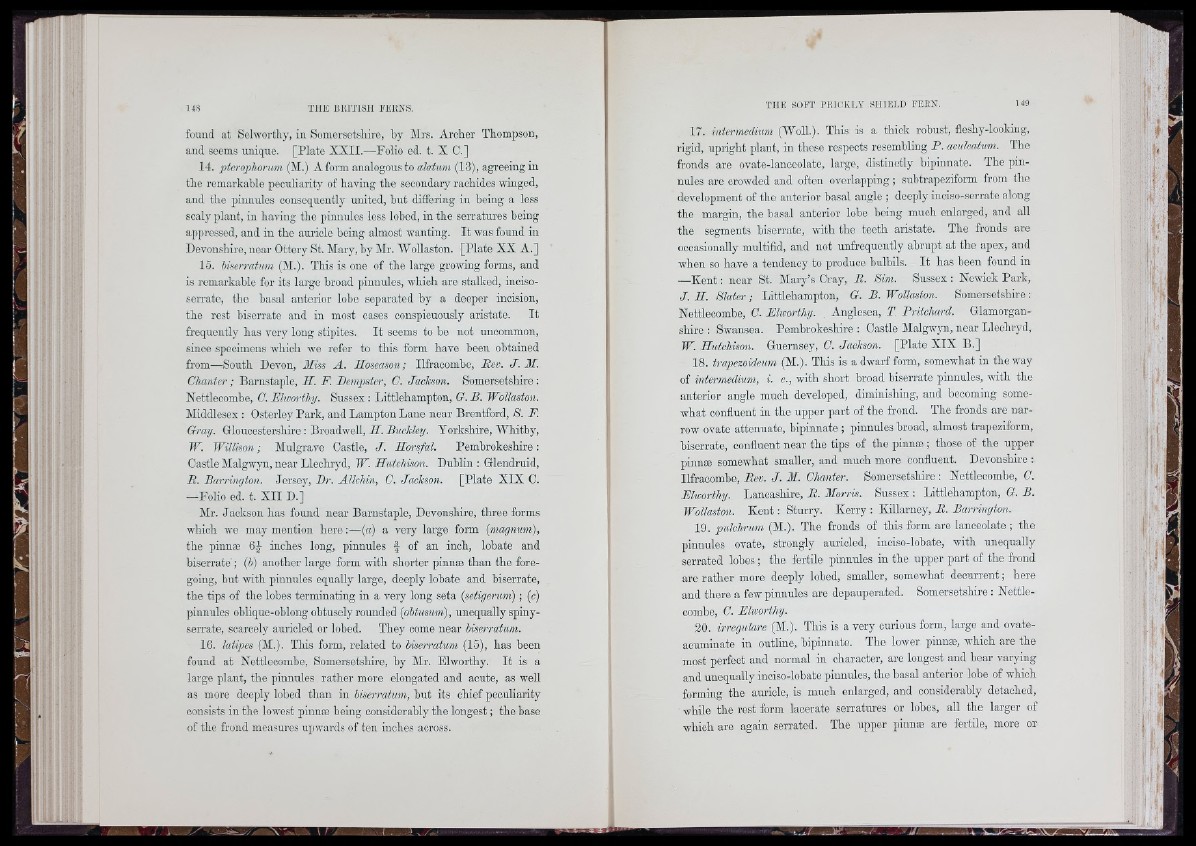
found at Selwoi'tliy, in Somersetsliiro, by Mrs. Archer Thompson,
and seems unique. [Plate X X II.—Folio ed. t. X C.]
14. ptcrophoriim (M.) A form analogous to alatum (13), agreeing in
the remarkable peculiarity of having the secondary raohides winged,
and the pinnules consequently united, but differing in boing a less
scaly plant, in having the pinnules less lobod, in the serratures being
appressed, and in the auriclo being almost wanting. I t was found in
Devonsliire, near Ottery St. IMary, by Mr. Wollaston. [Plate XX A.]
16. bisen-aiim (M.). This is one of the large growing forms, and
is remarkable for its large broad pinnules, which are stalked, inoiso-
serrate, tho basal anterior lobe separated hy a deeper incision,
the rest biserrate and in most oases conspicuously aristate. I t
frequently has very long stipites. I t soems to be not uncommon,
since specimens which we refer to this form have been obtained
from—South Devon, Miss A . Iloseason; Ilfracombe, Rev. J . M.
Chanter ; Barnstaple, II . F. Dempster, C. Jackson. Somersetshire :
Nettleoomhe, C. Ekcortluj. Sussex : Littlohampton, G. B. Wollaston.
Middlesex : Osterley Park, and Lampton Lane near Brentford, S. F.
Gray. Gloucestershire : Broadwell, II . Bucldey. Yorkshire, Whitby,
W. Willison ; Mulgrave Castle, J . Horsfal. Pembrokeshire :
Castle Malgwjm, near Llechryd, W. Hutchison. Dublin : Glendruid,
R. Barrington. Jersey, Dr. Allchin, C. Jackson. [Plate X IX C.
—Folio ed. t. X I I D.]
Mr. Jackson has found near Barnstaple, Devonshire, three forms
which we may mention h e re :—(«) a very large form {magnum),
the pinnæ 6 ] inches long, pinnules | of an inch, lobate and
biserrate'; (i) another large form with shorter pinnæ than the foregoing,
hut with pinnules equally large, deeply lohate and biserrate,
the tips of the lobes terminating in a very long seta {setigerum) ; (c)
pinnules oblique-oblong obtusely rounded {obtusiim), unequally spiny-
serrate, scarcely auricled or lobed. They come near biserraium.
16. latipes (M.). This form, related to biserratum (IS), has been
found at Nettlecombe, Somersetshire, by Mr. Elworthy. I t is a
large plant, tho pinnules rather more elongated and acute, as well
as more deeply lohed than in biserratum, but its chief peculiarity
consists in the lowest pinnæ being considerably the longest ; the 1
of the frond measures upwards of ton inches across.
17. intermedium (Woll.). This is a thick robust, fleshy-looking,
rigid, upright plant, in these respects resembling P . aculeatum. Tho
fronds are ovate-lancoolate, large, distinctly hipinnate. The pinnules
aro crowded and often overlapping ; snhtrapcziform from the
development of the anterior ba.sal angle ; deeply inciso-serrate along
the margin, the basal anterior lobe being much enlarged, and all
the segments biserrate, with the teeth aristate. The fronds are
occasionally multifid, and not unfrequontly abrupt at the apox, and
when so have a tendency to produce bulbils. I t has been found in
—Kent : near St. Mary’s Cray, B . Sim. Sussex : Newiok Park,
J . II. Slater ; Littleliampton, G. B. Wollaston. Somersetshire :
Nettlecombe, C. Elworthy. . Anglesea, T. Pritchard. Glamorgan-
sbire : Swansea. Pembrokeshire ; Castle Malgwyn, near Llechryd,
W. Hutchison. Guernsey, C. Jackson. [Plate X IX B.]
18. trapezoideum (M.). This is a dwarf form, somewhat in the way
of intermedium, i. e., with short broad biserrate pinnules, with the
anterior angle much developed, diminishing, and becoming somewhat
confluent in tho upper part of the frond. The fronds are narrow
ovate attenuate, bipinnate ; pinnules broad, almost trapeziform,
biserrate, confluent near the tips of the pinnæ ; those of the upper
pinnæ somewhat smaller, and much more confluent. Devonshire :
Ilfracombe, Bev. J . M. Chanter. Somersetshire : Nettlecombe, C.
Ehcorthy. Lancashire, R . Morris. Sussex : Littlehampton, O. B.
Wollaston. Kent : Sturry. Kerry : Killarney, R . Barrington.
19. pulehrum (M.). The fronds of this form are lanceolate ; the
pinnules ovate, strongly auricled, inciso-lobate, with unequally
serrated lobes ; the fertile pinnules in the upper part of the frond
are rather more deeply lobed, smaller, somewhat decurrent ; here
and there a few pinnules are depauperated. Somersetshire : Nettle-
comhe, C. Ehcorthy.
20. irreguläre (M.). This is a very curious form, large and ovate-
acuminate in outline, bipinnate. The lower pinnæ, which are the
most perfect and normal in character, are longest and hear varying
and unequally inciso-lohate pinnules, the basal anterior lobe of which
forming the auricle, is much enlarged, and considerably detached,
while the rest form lacerate serratures or lobes, all the larger of
which are again serrated. The upper pinnæ are fertile, more or
"A
I '
■ }k-: ,
ri'-
; ' :
.f t